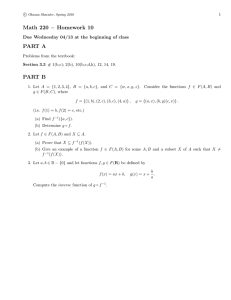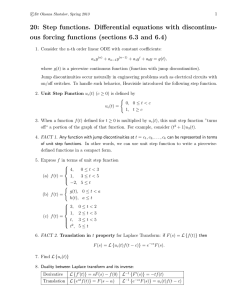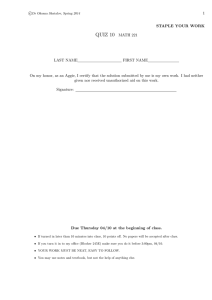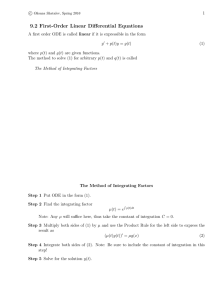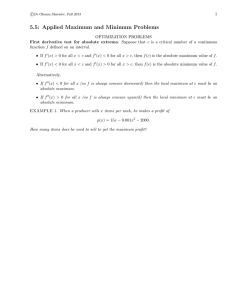Document 10583156
advertisement
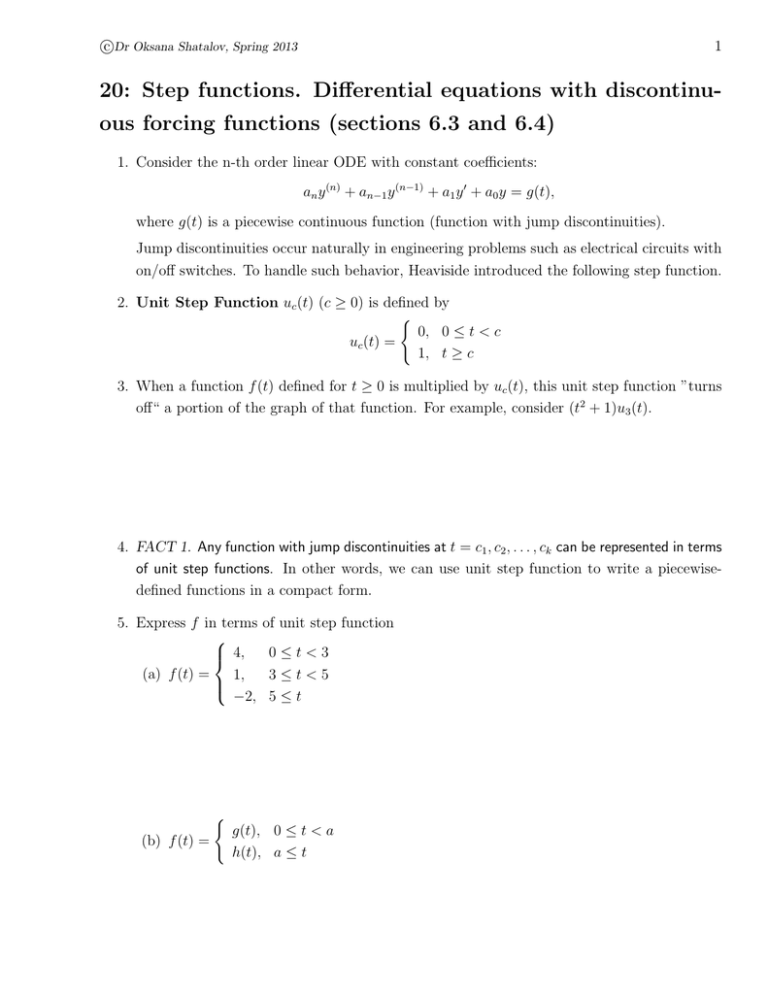
c Dr Oksana Shatalov, Spring 2013
1
20: Step functions. Differential equations with discontinuous forcing functions (sections 6.3 and 6.4)
1. Consider the n-th order linear ODE with constant coefficients:
an y (n) + an−1 y (n−1) + a1 y 0 + a0 y = g(t),
where g(t) is a piecewise continuous function (function with jump discontinuities).
Jump discontinuities occur naturally in engineering problems such as electrical circuits with
on/off switches. To handle such behavior, Heaviside introduced the following step function.
2. Unit Step Function uc (t) (c ≥ 0) is defined by
(
0, 0 ≤ t < c
uc (t) =
1, t ≥ c
3. When a function f (t) defined for t ≥ 0 is multiplied by uc (t), this unit step function ”turns
off“ a portion of the graph of that function. For example, consider (t2 + 1)u3 (t).
4. FACT 1. Any function with jump discontinuities at t = c1 , c2 , . . . , ck can be represented in terms
of unit step functions. In other words, we can use unit step function to write a piecewisedefined functions in a compact form.
5. Express f in terms
4,
(a) f (t) =
1,
−2,
(
(b) f (t) =
of unit step function
0≤t<3
3≤t<5
5≤t
g(t), 0 ≤ t < a
h(t), a ≤ t
c Dr Oksana Shatalov, Spring 2013
3,
1,
(c) f (t) =
t,
2
t,
2
0≤t<2
2≤t<3
3≤t<5
5≤t
6. FACT 2. Translation in t property for Laplace Transform: if F (s) = L {f (t)} then
F (s) = L {uc (t)f (t − c)} = e−cs F (s).
7. Find L {uc (t)}
8. Duality between Laplace transform and its inverse:
Derivative
Translation
L {f 0 (t)} = sF (s) − f (0) L−1 {F 0 (s)} = −tf (t)
L {eαt f (t)} = F (s − α)
L−1 {e−cs F (s)} = uc (t)f (t − c)
9. Let f (t) will be the same as in 5(c). Find L {f }.
c Dr Oksana Shatalov, Spring 2013
3
10. Find the inverse Laplace transform of
H(s) =
e−4s
se−3s
+
s2 + 9 s2 + 4
c Dr Oksana Shatalov, Spring 2013
11. Let
4
20, 0 ≤ t < 3π,
g(t) =
0, 3π ≤ t < 4π
20, 4π ≤ t
(a) Solve IVP:
y 00 + 2y 0 + 2y = g(t),
y(0) = 10,
Solution:
Step 1. Express g(t) in compact form.
Step 2. Find L {g(t)} = G(s).
Step 3. Find L {y 00 + 2y 0 + 2y}.
Step 4. Combine steps 2& 3 to get L {y(t)} = Y (s).
y 0 (0) = 0,
c Dr Oksana Shatalov, Spring 2013
5
Step 5. Apply inverse Laplace transform to find y(t). This step usually requires partial
fraction decomposition.
(b) Sketch the graph of y(t).
